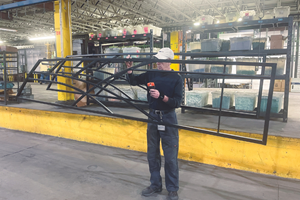Allowable Limits for Phosphate Waste
Question: We are about to incorporate a batch powder-coating system into our production and intend to phosphatize a very small amount of bare steel sheet prior to coating.
Question:
We are about to incorporate a batch powder-coating system into our production and intend to phosphatize a very small amount of bare steel sheet prior to coating. While it appears that the amount of acidic effluent is so minimal (estimated at 140 ppm of total wastewater discharge) as to be of no concern, I have not been able to determine the allowable limits that EPA has for injection wells or discharge into private septic systems. Can you steer me in the right direction? Also, the microbiologists I’ve spoken with feel that phosphoric acid at these minimal levels would not inhibit biological activity in the septic system. Do you have any experience with similar situations? Any info you have would be appreciated. T.S.
Answer:
Your questions could take many pages to fully answer, but let me bring up several issues.
First, I assume that your proposed phosphatizing wastewater is not a RCRA hazardous waste. That is, its pH is between 2.0 and 12.5 and its metal concentrations for arsenic, barium, cadmium, chromium, lead, mercury, selenium and silver would pass the Toxicity Characteristic Leaching Procedure (TCLP). Making this assumption and based upon your information, your septic tank system would be classified as a Class V injection well. While these types of wells are allowable, U.S. EPA regulations require that, at a minimum, you must notify your state EPA or U.S. EPA regional office, depending who has underground injection control (UIC) authority in your state as required by 40 CFR 144. They would then make a determination if you require a UIC permit. Furthermore, Class V wells must meet certain criteria and standards as required by 40 CFR 146-Subpart F. These include construction features, nature and volume of wastewater, assessment of contamination potential, assessment of available corrective alternatives and recommendations for remedial action. Lastly, it is the policy of U.S. EPA and many states to strongly discourage the construction of new Class V wells and encourage the closing of existing Class V wells. In summary, for the small amount of wastewater that you expect to generate, it is my opinion that the number of regulatory hurdles that you would have to overcome to permit this discharge is not worth it. Furthermore, I strongly recommend that you do not discharge in this manner due to its high risk and liability. May I suggest several alternatives assuming that a sanitary sewer is not nearby.
You could investigate the feasibility of a direct discharge to the nearest surface water after treatment. Again, for small dischargers, the permitting and ongoing compliance costs can be expensive, especially with biological monitoring typically required for finishing discharges. This test can cost $1,500-5,000.
You can evaluate, along with your phosphate equipment supplier, the option of recycling and reusing the wastewater through the use of chemical treatment and filtration. The residuals or wastes generated by this process would then be shipped offsite for disposal or its volume further reduced by evaporation before offsite disposal.
If reusing the wastewater is not feasible, another option is to collect the wastewater and dispose of it offsite, or, again, further reduce its volume by evaporation before offsite disposal.
While all of these options are technically proven and feasible, your decisions will likely be guided by their costs.
Related Content
Powder Coating Overcomes Post Forming
Six Sigma methodology, open communication, and collaboration produce results for leading boat manufacturer.
Read MoreAn Altruistic Growth Strategy Puts People First
Professional Plating emphasizes investing in its team and fostering a supportive environment on the shop floor.
Read MoreAdjusting Current and Voltage When Powder Coating
Which manual powder coating gun setting is better to adjust, voltage or current? Jeff Hale of Gema USA discusses when to use different settings on your powder gun to achieve optimal results.
Read MoreTTX’s Automated Conveyor Carrier System Offers Wireless, Flexible Operation
ACC system designed for reliable, consistent point-to-point movement of everything from small to heavy parts.
Read MoreRead Next
A ‘Clean’ Agenda Offers Unique Presentations in Chicago
The 2024 Parts Cleaning Conference, co-located with the International Manufacturing Technology Show, includes presentations by several speakers who are new to the conference and topics that have not been covered in past editions of this event.
Read MoreEducation Bringing Cleaning to Machining
Debuting new speakers and cleaning technology content during this half-day workshop co-located with IMTS 2024.
Read MoreEpisode 45: An Interview with Chandler Mancuso, MacDermid Envio Solutions
Chandler Mancuso, technical director with MacDermid Envio discusses updating your wastewater treatment system and implementing materials recycling solutions to increase efficiencies, control costs and reduce environmental impact.
Read More














.jpg;maxWidth=300;quality=90)







